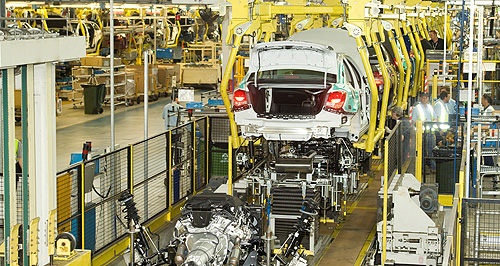Make / Model Search
News - HoldenHolden workers back survival planCold cuts: Holden workers have voted to accept a range of wide-sweeping changes to the way they are paid to help the car-maker survive until at least 2022. Australian car-making still on shaky ground despite Holden workers backing cuts16 Aug 2013 By BARRY PARK HOLDEN’S workforce has voted to endorse a raft of radical changes to the way they are paid in an effort to keep the company building cars in Australia. “Following a ballot at all Holden sites across South Australia and Victoria, Holden’s workforce has voted to accept the proposed changes to the enterprise bargaining agreement (EBA) by a strong majority,” Holden said in a statement released late today. “Per the normal process, Holden will now submit the variation to the Fair Work Commission for approval.” Workers at the car-maker’s Adelaide and Port Melbourne plants were asked to vote on an amendment to an enterprise bargaining agreement struck last year, which will help Holden improve its competitiveness and save on the $3750 extra the company says it costs to build cars here compared to other countries overseas. About $2000 of that cost is attributed directly to wages, Holden said. The economy measures voted in this week will alone help Holden save about $15 million a year. Holden has held off making an announcement on the progress of voting, which started with the car-maker’s 1700 workers in Adelaide early this week and ended with a vote of Lang Lang proving ground engineering and development staff late today. Holden managing director Mike Devereux thanked Holden’s workforce for its loyalty and flexibility. “Changes like this are never easy and the ‘yes’ vote is a huge commitment from the hard-working men and women of our Holden team,” Mr Devereux said. “These labour-related cost savings and productivity improvements are crucial to putting our Elizabeth manufacturing facility on a path to global competitiveness. “Australia is a high-cost country not just for making cars but for making anything. It was critical that we reduced our costs and delivered flexible and contemporary work arrangements.” Meanwhile, the union representing the majority of Holden’s blue-collar workforce has called on politicians to back up the vote outcome and support the car-maker’s efforts to remain in Australia. However, the Australian Manufacturing Workers Union pointed out that the revised agreement would only take effect if Holden committed to building new facilities at Elizabeth to make the next generation of Cruze small cars and Commodore large cars from 2016 to 2022. Workers have agreed to give up a three percent wage rise due in November, as well as introduce changed working hours and shift arrangements. As part of the deal, Holden will also be able to sack workers if they are deemed inefficient, or even if they abuse sick leave entitlements. The union said about 450 Holden workers in Melbourne also had the right to vote on the changed union agreement, but most abstained as the variation does not apply to their workplace. “It was very stressful, everyone was well aware that it would be devastating to South Australia and probably the entire country’s economy if Holden packed up and left,” Adelaide-based union delegate Murray Akehurst said. “Now it’s up to the politicians, you know… we’ve shown we’re prepared to make changes to keep Holden here so it would be pretty poor if either side said they won’t follow up with proper investment to work with the company to stay,” union leading delegate Heinz Joham said. “How could they risk destroying a community? They have to show leadership.” Holden posted a $152.8 million loss last financial year as a rising Australian dollar made it more expensive to build cars here, while a weakening of the Japanese yen made it cheaper for other car-makers to import. Holden has said its US-based parent company, General Motors, will make a final decision on its Elizabeth operations after the election, with a decision due about October. Holden’s Mr Devereux said the car-maker would sit down with “whichever party is at the Lodge” to talk about establishing ongoing commitment to the industry. GM has tentatively approved spending about $1.2 billion to introduce new lines to build the next generation of cars in Australia, with the Commodore expected to move to a new global platform that is likely to acquaint Australian buyers with a front- or all-wheel-drive cars rather than the traditional rear-wheel-drive large cars built here. Holden is also competing with its largest supplier, GM Korea, to establish itself as a production stronghold, particularly as the US-based parent struggles with rising production costs and increasing unionisation in South-East Asia. GM Korea’s production costs per vehicle over and above the company’s average – it supplies the Cruze wagon, Captiva soft-roader, Barina small car, and the Barina Spark city car to Holden – was tipped by the company to hit more than $US1100 this year, making it, just like Australia, what GM considers a high-cost market in which to build cars. Korea will continue to make the current Cruze range for export to emerging markets such as China, while Holden is believed to be vying for production of the next-generation model which is expected to include hybrid and electric models. Korea has a reputation for militant unionism. Workers wielding metal pipes stormed the office of GM Korea’s chief financial officer late last year demanding, among other things, more meal subsidies. They have also organised rolling strikes earlier this year after talks over wage rises hit a roadblock. GM’s concerns about spiralling wage costs have raised speculation that the US car-maker is gearing up to pull out of South Korea – a factor that will likely play into Australia’s advantage.  Read more |
Click to shareHolden articlesResearch Holden Motor industry news |










Facebook Twitter Instagram